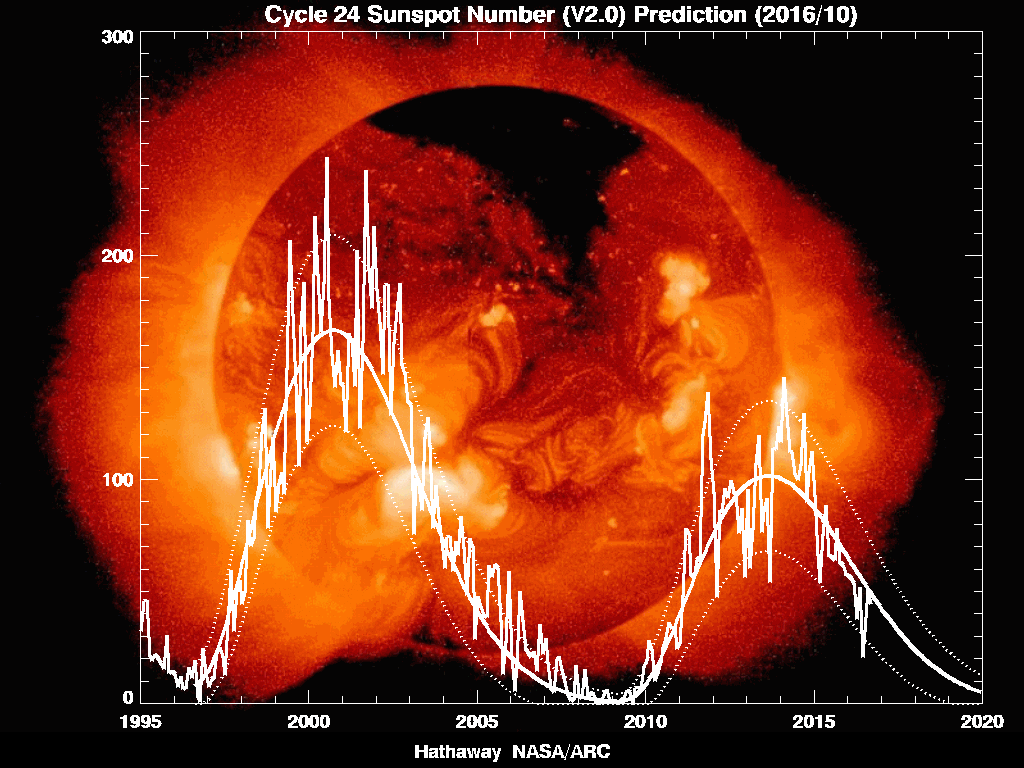The predictions for solar cycle 24 have been plunging since the December 2006 prediction that it would be "one of the most intense cycles since record keeping began almost 400 years ago":
Dec. 21, 2006: Evidence is mounting: the next solar cycle is going to be a big one. Solar cycle 24, due to peak in 2010 or 2011 "looks like its going to be one of the most intense cycles since record-keeping began almost 400 years ago," says solar physicist David Hathaway of the Marshall Space Flight Center. He and colleague Robert Wilson presented this conclusion last week at the American Geophysical Union meeting in San Francisco.Animation of prior changes to Dr. Hathaway's solar cycle 24 predictions:
The predictions for Solar Cycle 24 have plummeted from "one of the most intense" to now one of the least intense cycles of the past 400 years. If the anemic activity continues, the sun may be entering a quiet phase similar to the Dalton Minimum, characterized by approximately 50 sunspots/month at the peak of the solar cycle.


Nov 12, 2003: “The Sun Goes Haywire – Solar maximum is years past, yet the sun has been remarkably active lately. Is the sunspot cycle broken?”
ReplyDeletehttp://science.nasa.gov/headlines/y2003/12nov_haywire.htm
Oct 18, 2004: “Something strange happened on the sun last week: all the sunspots vanished. This is a sign, say scientists, that solar minimum is coming sooner than expected.”
http://science.nasa.gov/headlines/y2004/18oct_solarminimum.htm
May 5, 2005: “Solar Myth – With solar minimum near, the sun continues to be surprisingly active.”
http://science.nasa.gov/headlines/y2005/05may_solarmyth.htm
Sept 15, 2005: “Solar Minimum Explodes – Solar minimum is looking strangely like Solar Max.”
http://science.nasa.gov/headlines/y2005/15sep_solarminexplodes.htm
Aug 15th, 2006: “Backward Sunspot – A strange little sunspot may herald the coming of one of the stormiest solar cycles in decades.”
http://science.nasa.gov/headlines/y2006/15aug_backwards.htm
Dec 21, 2006 “Scientists Predict Big Solar Cycle – Evidence is mounting: the next solar cycle is going to be a big one.”
http://science.nasa.gov/headlines/y2006/21dec_cycle24.htm
Dec 14, 2007 “Is a New Solar Cycle Beginning? – The solar physics community is abuzz this week. ”
http://science.nasa.gov/headlines/y2007/14dec_excitement.htm
Jan 10, 2008: “Solar Cycle 24 – Hang on to your cell phone, a new solar cycle has just begun.
http://science.nasa.gov/headlines/y2008/10jan_solarcycle24.htm
March 28, 2008: “Old Solar Cycle Returns – Barely three months after forecasters announced the beginning of new Solar Cycle 24, old Solar Cycle 23 has returned.”
http://science.nasa.gov/headlines/y2008/28mar_oldcycle.htm
July 11, 2008: “What’s Wrong with the Sun? (Nothing) – Stop the presses! The sun is behaving normally.”
http://science.nasa.gov/headlines/y2008/11jul_solarcycleupdate.htm
Sept. 30, 2008: “Spotless Sun: Blankest Year of the Space Age
- Sunspot counts are at a 50-year low – We’re experiencing a deep minimum of the solar cycle.”
http://science.nasa.gov/headlines/y2008/30sep_blankyear.htm
Nov. 7, 2008: The Sun Shows Signs of Life – I think solar minimum is behind us”
http://science.nasa.gov/headlines/y2008/07nov_signsoflife.htm
April 1, 2009: Deep Solar Minimum – We’re experiencing a very deep solar minimum – This is the quietest sun we’ve seen in almost a century”
http://science.nasa.gov/headlines/y2009/01apr_deepsolarminimum.htm
May 29, 2009: “If our prediction is correct, Solar Cycle 24 will have a peak sunspot number of 90, the lowest of any cycle since 1928 when Solar Cycle 16 peaked at 78,”
http://science.nasa.gov/headlines/y2009/29may_noaaprediction.htm
June 17, 2009: “Mystery of the Missing Sunspots, Solved? The sun is in the pits of a century-class solar minimum, and sunspots have been puzzlingly scarce for more than two years.”
http://science.nasa.gov/headlines/y2009/17jun_jetstream.htm
September 3, 2009: “Are Sunspots Disappearing? – The sun is in the pits of the deepest solar minimum in nearly a century. Weeks and sometimes whole months go by without even a single tiny sunspot. The quiet has dragged out for more than two years, prompting some observers to wonder, are sunspots disappearing?
http://science.nasa.gov/headlines/y2009/03sep_sunspots.htm
September 29, 2009 “Cosmic Rays Hit Space Age High – In 2009, cosmic ray intensities have increased 19% beyond anything we’ve seen in the past 50 years,” says Richard Mewaldt of Caltech. “The increase is significant, and it could mean we need to re-think how much radiation shielding astronauts take with them on deep-space missions.”
http://science.nasa.gov/headlines/y2009/29sep_cosmicrays.htm
How much data is available for such predictions?
ReplyDeleteIt seems more complicated with unknown variables than Hurricane or seismic activity. I think predictions serve little at this stage of science.
However, EMP's are predictably destructive to our primitive technologies, so show a little respect
for the possibilities and don't conflate your
disdain for global warming theories with the dangers of solar activity.
Professor Vladimir Paar, who has studied ice ages for decades, made the prediction we would end the Holocene and see glaciation cycle onset within about 5 years. That was one or two years ago. For geological timing purposes, I think he hit the bulls eye. I hope my life is long enough so I am around when science knows just why the volcanic activity kicks up like this, right at the start of an ice age, in conjunction with the deep solar quiet being extended. It is a sort of accelerating effect. When Katla or some other volcano finally blows in a big way and the solar reflectivity of that and more snow and ice kick in good, humanity will need to adapt and hopefully keep some record of all this.
ReplyDelete